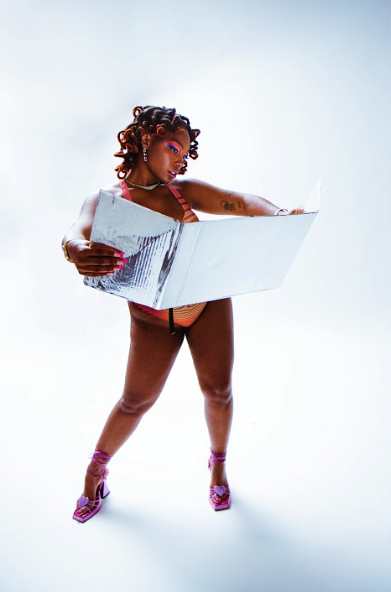Koko Bayer Pushes a Social Agenda Through “Light Vandalism”

Addison Herron-Wheeler is OUT FRONT's co-publisher and editor-in-chief and friend…
Graffiti is a powerful medium for spreading messages. For Koko Bayer, it is a cathartic release and a way to educate her community on important social issues.
Bayer is one of the staple artists of the once-flourishing River North arts community. Soon, that neighborhood will be home to a World Trade Center, a light rail stop, and many new apartment complexes. Her neighborhood is rapidly changing, but Bayer found a way to continue working in RiNo when she ditched her gallery space and transformed her apartment into a work studio.
But her art is still visible on the streets of RiNo, and the remains of her work can be found in the rubble of the buildings that once housed many galleries but were torn down to make room for Denver’s growing population.
Grinding to a stop, Bayer wasted no time jumping out of her Jeep Wrangler to show off one of her favorite walls in the RiNo neighborhood. Located on the side of an abandoned building, Bayer lamented that the spot will soon be torn down, and her work with it.

“Plenty of my pieces have gone down in this neighborhood when they brought down the buildings,” she said. “I still have a lot of pieces up, but there are definitely some that have gotten demolished.”
Bayer creates graffiti as a catharsis, a release from the technology she immerses herself in during her day-to-day work. She also does it as a way to break through and reach the community through interactive art.
Technically, what Bayer is doing is illegal, but she fondly refers to it as “vandalism light.”
Unlike graffiti done with spray paint, all of her pasted illustrations can be washed off with water and are not intended to be permanent or damage the buildings they are on. She also seeks out spots with pieces already on them, properties she knows to be abandoned, or owners who are friendly to local artists.
“There’s a certain street code that goes along with this kind of work,” Bayer explained. “If I were to wheatpaste over another artist’s work, that would be an act of aggression. I seek out spaces with other pieces and try to put my work where I know it’s OK.”
One of those places is located in the heart of Capitol Hill. As she approached the spot, a smile crept up from behind the steering wheel.
Bayer’s appearance forms a sharp contrast with the rugged jeep she rides around in. Donning a blue and white blouse, with her hair and makeup done, she takes a lot of pride in her appearance, even in the middle of summer as she lugs her equipment through town. Her Jeep, on the other hand, is dusty and open-air, filled with a bucket of wheatpaste, a large brush for attaching her work to walls, and all of her prints.
“This next spot is a little hidden, but still great for pasting,” Bayer said of a secluded wall tucked behind City o’ City. “My work won’t be as visible here, but I try to contribute to this spot because a lot of artists visit here.”
The wall behind City o’ City already features some of Bayer’s existing work. A pair of lips plastered to the wall, once bright red, have turned black, but still remain proudly displayed. Standing in front of the wall and her faded lips, Bayer pulled out a giant image of a rainbow hand with an eyeball in the center and began pasting it alongside other artists’ work.
“This piece I made specifically for Pride, even though I’m not always super political with my work,” Bayer explained.

As a lesbian trans woman, Bayer does not want her LGBTQ identity to define or inform all of her art, but she wants to embrace the power that she has to create change and influence opinion by pasting her art across the city.
While she doesn’t see herself as an artist that works being queer into every piece of art or aspect of what she does, Bayer has recently been working on LGBTQ-oriented projects. She did a series for Pride Month featuring rainbow hearts, eyes, and hands that she put up all over town.
“I always just think of myself as an artist, not with anything added on to that,” she said.
“But I think this election has really made us think and clarify what exactly we think. Working with the Amplifier Foundation [a national LGBTQ street art crew] and doing all the ‘We the People’ postering around town was really empowering and showed me that my art can also be this tool to share my opinions and really make people think about certain things, and that really got my attention. It kind of shows you that there’s this additional layer that your art can have if you choose for it to. At the end of the day it still needs to be good art — not just good queer art or good woman’s art. If I can do good art that also helps educate people I think that would be a beautiful bonus, and it would be so gratifying.”
The “We the People” series refers to the posters that have been popping up around town, reminiscent of World War II-era propaganda posters. One features a woman wearing an American-flag Hijab, and the other shows a brown-skinned woman with a flower in her hair.
The posters made a bigger impact than a lot of the more esoteric pieces she posts. Many were defaced, causing Bayer to drive around fixing and pasting over the ruined posters. Bayer doesn’t seem bitter about the art being destroyed, but rather encouraged that people are noticing her work and starting a dialogue based on it, and happy that she has received positive feedback for the project as well.
On the same wall as her faded lips and newly pasted rainbow hand, Bayer pointed out one of the “We the People” pieces — the one without the hijab.
“I loved putting this here because of the visibility for people,” she explained. “These have definitely been pieces that received a really strong reaction.

Taking out her phone, she pulled up a photo of her hijab piece after it was defaced, the words “stop female genital mutilation” scrawled across the image.
Despite the defacing of some of her pieces, Bayer seems positive about the fact that her audience is reacting to and interacting with her pieces.
“It really has been so gratifying doing the ‘We the People’ thing, and every time I have replaced that piece across from City o’ City, someone has come up and said how much they appreciate having that piece there,” she said. “A lot of times as artists we don’t have that much contact with other people, really. Making art, for the most part, is a solitary enterprise. I think that’s part of why I like making art in the streets. It’s a semi-solitary enterprise but sometimes you interact with people.”
Bayer works as a photographer to pay the bills but does wheatpasting as a way to blow off steam and meditate on a solitary activity. She considers all of her art a collaboration with her late grandfather, Herbert Bayer, who was one of the pioneers of the Bauhaus Movement.
The process of pasting is easy enough that Bayer can accomplish it with a few basic items from her jeep. She keeps a bottle of wheatpaste, which she mixes herself from a water and flour solution. Bayer squirts the paste up on the wall and then flattens the illustration onto the wall with the roller she carries.
“You know, for me, there is something beautifully low tech about it,” she said. “There is something very simple, almost preschool-like. Glue and paper and water — that’s it. And I love the actual act; I love putting them up. I’m just thinking of the wall, the paper, the glue; it’s very liberating; the zone or flow is super addictive. It’s such a good feeling and something I’ve gotten from art since I was a kid.”
Once Bayer was nestled comfortably back in her Wrangler and making her way through RiNo, she passed the location of the future World Trade Center and the new condos that will surround it. Bayer turned nostalgic, yet optimistic, about the neighborhood.
“All of that over there used to be studios; it was where I had my studio,” she said, gesturing to some apartments. “Now I live in Taxi, in one of the newer apartments. But I still have a workspace over there, and now there’s an organic grocery store I can walk to from my house. You can’t argue with that.”
Bayer will continue to use her positive influence through art to educate and reach people, and she still believes in the power of local D.I.Y. culture. In the meantime, Bayer would like for all of us to do her one favor.
“Come out of the closet,” she insisted. “Trans people especially need to come out of the closet. Those people in the closet are doing themselves and all of us a huge disservice. They are projecting onto the world what they think the world is going to think about them and that is informed by sexism, fear, and shame. If you give people an honest chance to accept you for who you are, the overwhelming majority of people will.”
What's Your Reaction?
Addison Herron-Wheeler is OUT FRONT's co-publisher and editor-in-chief and friend to dogs everywhere. She enjoys long walks in the darkness away from any sources of sunlight, rainy days, and painfully dry comedy. She also covers cannabis and heavy metal, and is author of Wicked Woman: Women in Metal from the 1960s to Now and Respirator, a short story collection.










